Hello hello.
So its been 20 days since the setup.
The aquarium plants are thriving, fish are delivering their fry.
The pH from day one to now went from 7,2 to 7,6. But it stopped there more than week ago.
So I'm quite sure it was the boulder that I place on top of my driftwood that was slowly raising the pH.
After I removed it the pH stayed at the same reading.
I did several small water changes, up to 10% a day, skipping a day here and there. Usually it was about 7-8%
The GH from day one to 10th day raised 5 or 6dGH, then I started performing those small water changes to keep it down, further I removed the stone, this is another reason to think that it was also responsible for raising my pH and my KH, more on that later.
I removed the stone o May 27th, but I was doing some water changes since May 23rd, but the GH kept raising by the next day. With the stone in I managed to reduce it to 13dGH, but it raised shortly after.
After I removed the stone the readings were more consistent
The KH raised from 3dKH to a weak 5dKH after I put the stone into the aquarium on May 16th, so it stayed there for eleven days.
Why I say a weak 5dKH? Because the test didn't become a strong yellow after the fifth drop, but it was yellow nonetheless.
Recently I ask for help identifying a crypto of mine, and it was said it could be a C. Balansae
So I went to my lfs and bought a tissue grow of a Cryptocoryne Crispatula var. balansae. To check if my previous crypto was the same. So I planted it in my tank to see what it turns out.
Ado. (Yet I'm a beginner on identifying aquarium plants.
One part of me thinks "Cryptocoryne Balansae and Cryptocoryne Crispatula var. balansae are the same plant"
But other part of me thinks they could be different species therefore I would have two types balansae? Is that so? Or I'm just tripping?
They are different, the leaves in the newer one was way more crenate than my previous one when I first bought it. So that could be a Cryptocoryne Spiralis, as I found it on sale on the same fish store that I bought it back then.
But, when I bought my first crypto, I didn't buy I tissue growth, I bought it already in the the submerged form.
But the store owner told me that he has the C. Spiralis in vitro and submerged grown. I didn't asked about the C. balansae, shame on me.)
I also added a small portion of C. wendtii "Green Gecko"
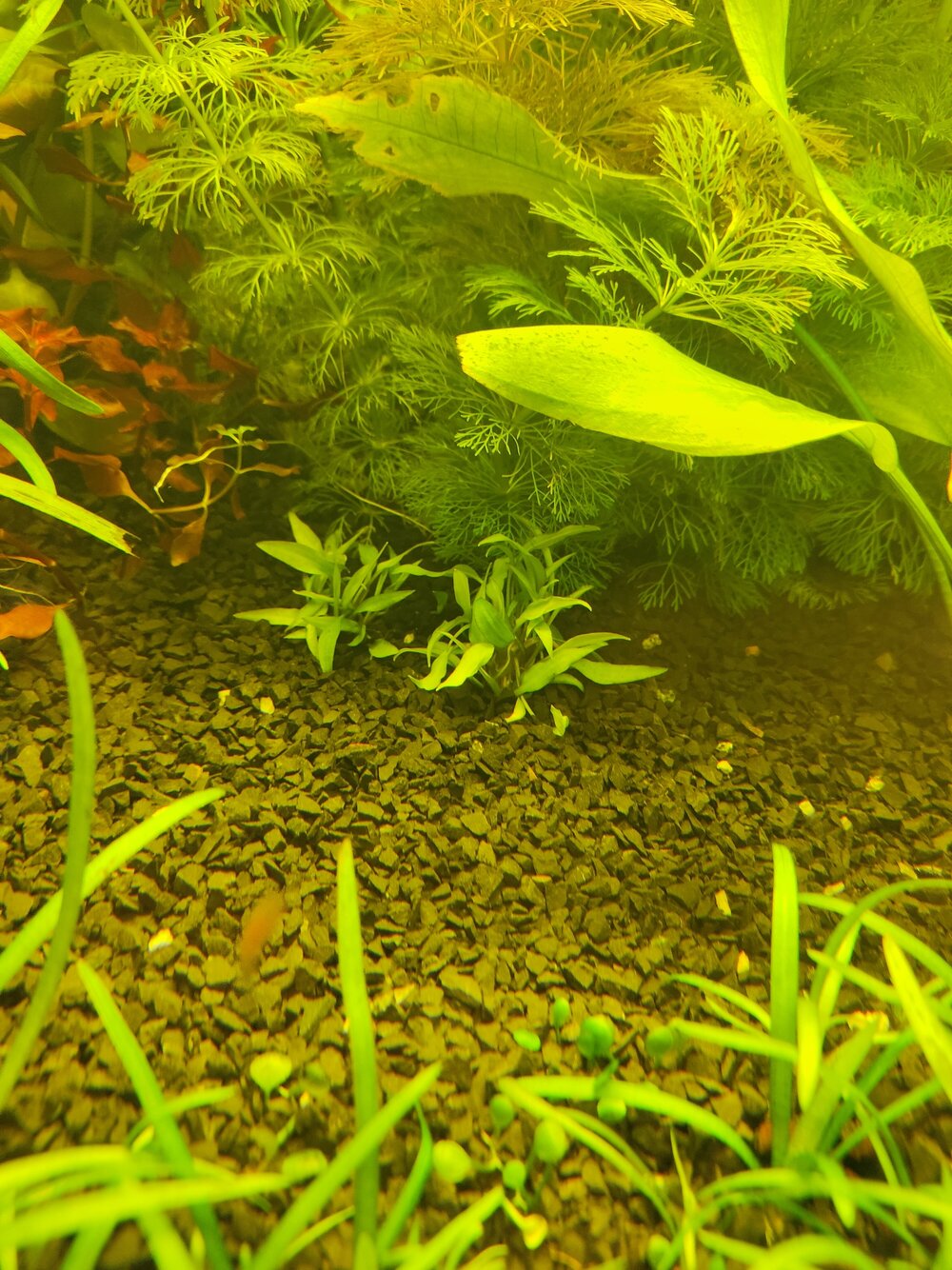
and my first buce: Bucephalandra Brownie Ghost:
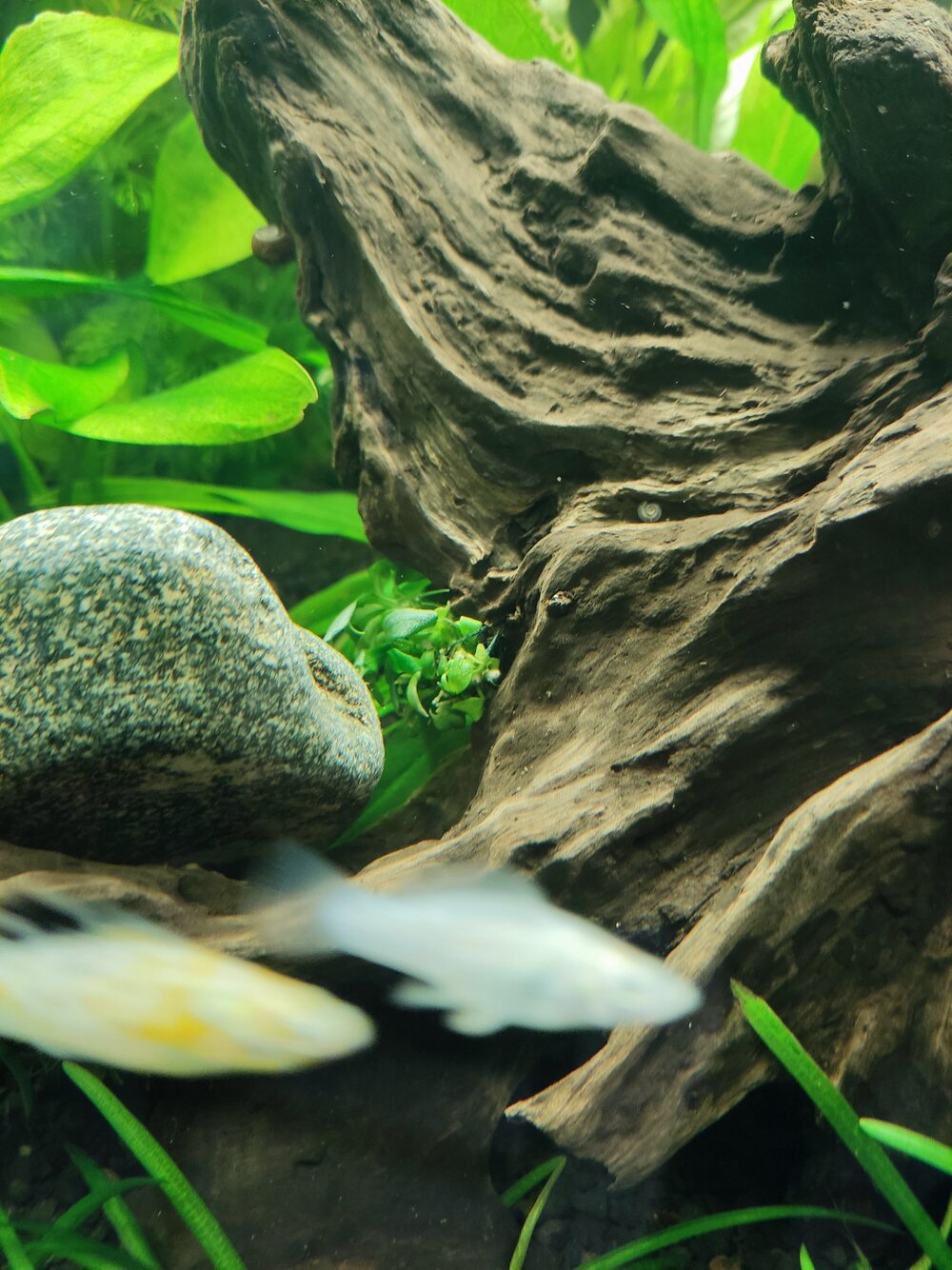
Yep, they are really small.
I payed R$38,00 for each Cryptocoryne (tissue growth) and R$65,00 for the buce (it came two small portion, but the second I planted behind the driftwood in a shaded area with more water flow.
I don't have any pictures of the C. crispatula var. balansae.
On May 30th, the plants were quite overgrown.
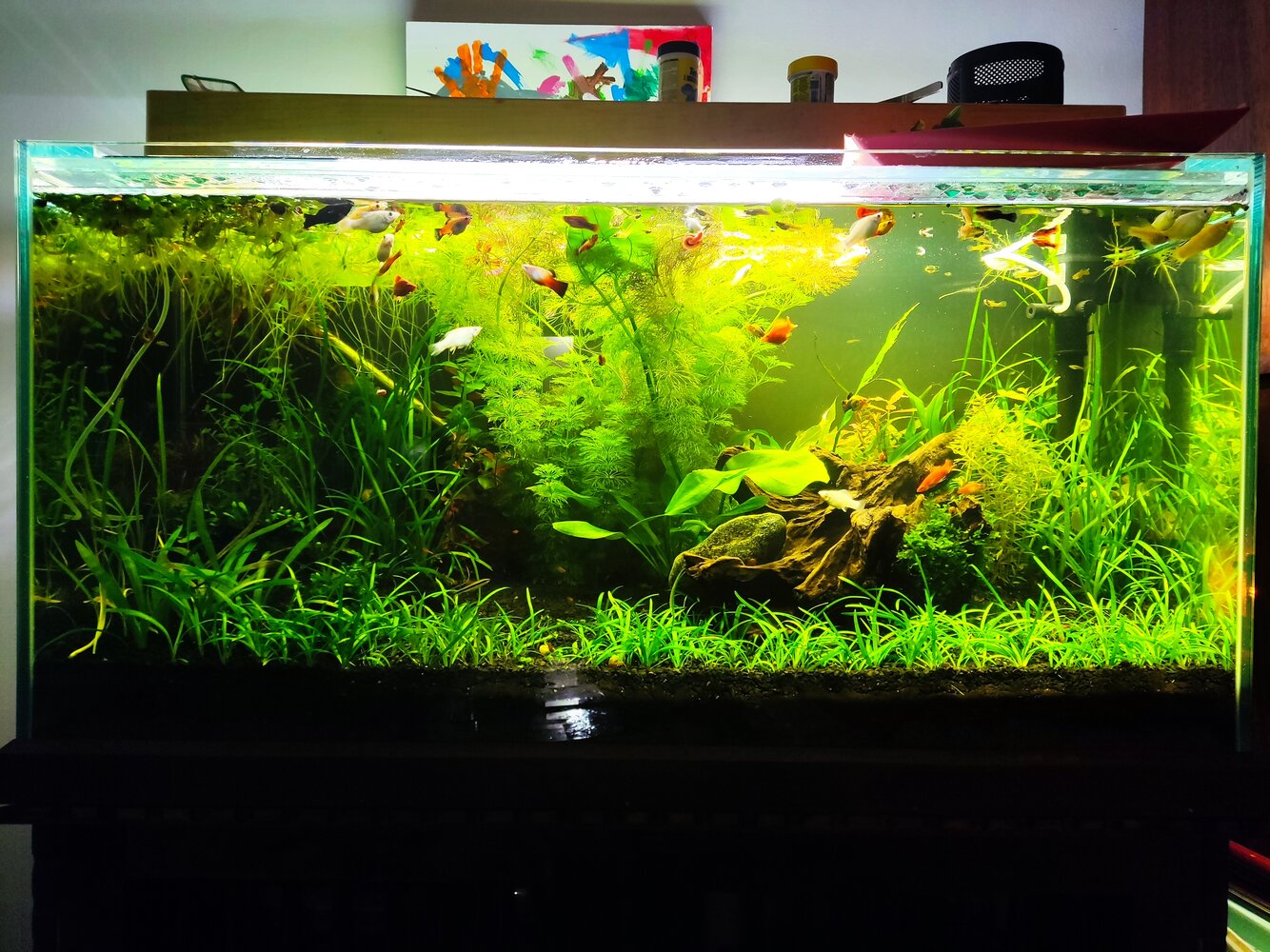
The Limnophila sessiflora, grew quite large very quickly, and send side shoots in many stems (in the previous tank it didn't happen as much as it happened in this one)
The floating plants took over the surface in no time, the new plants had shorter roots, which I think was because they came from an outside bucket with almost no plant food to an aquarium rich in plant food and ferts (DIY KCl and Seashem Flourish)
So I decided to squip the fertilization this week
After the trimmings it got like this:
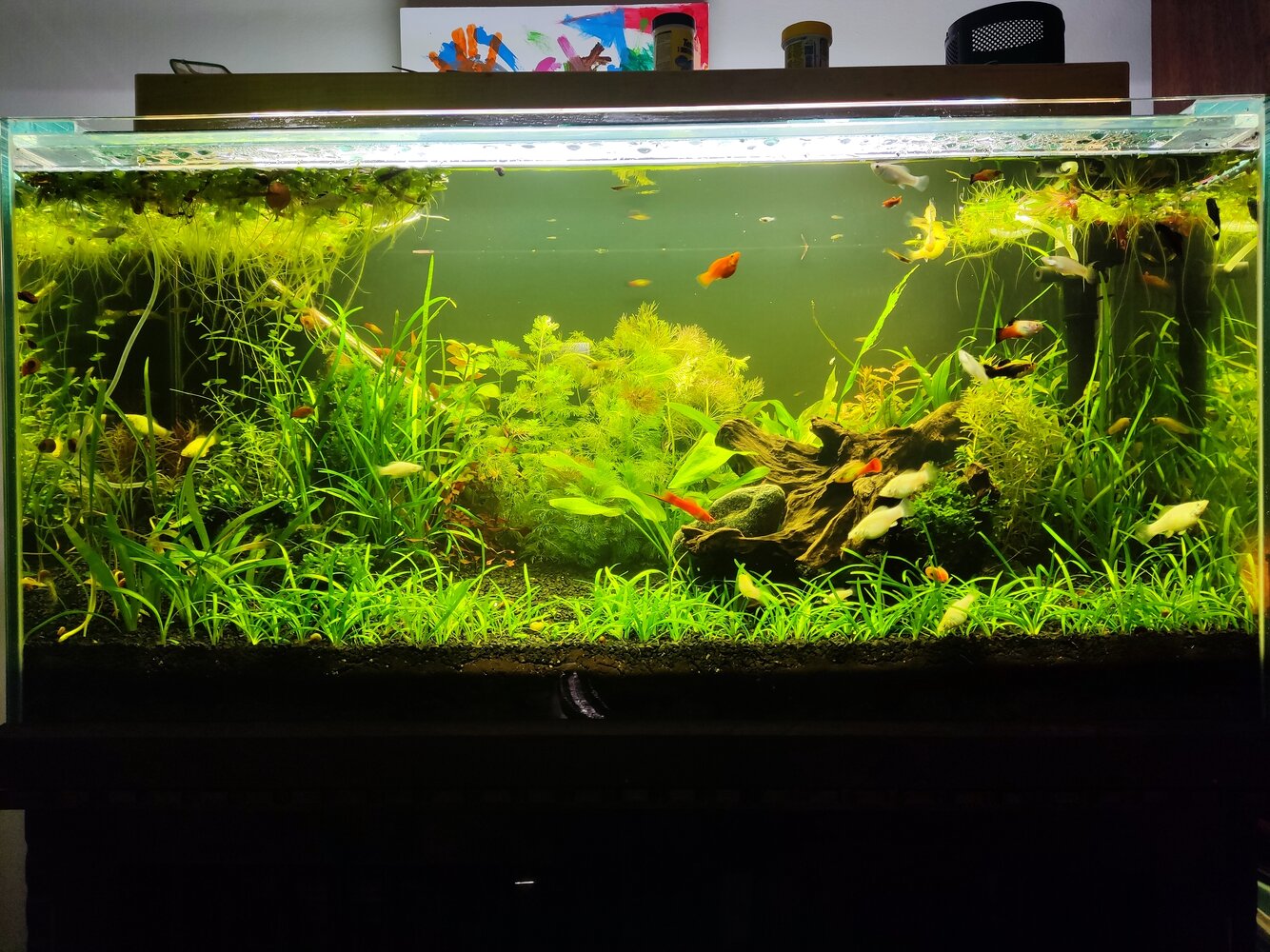
(First trimmings, May 30th)
But It has already overgrown.
This is the picture of my tank now:
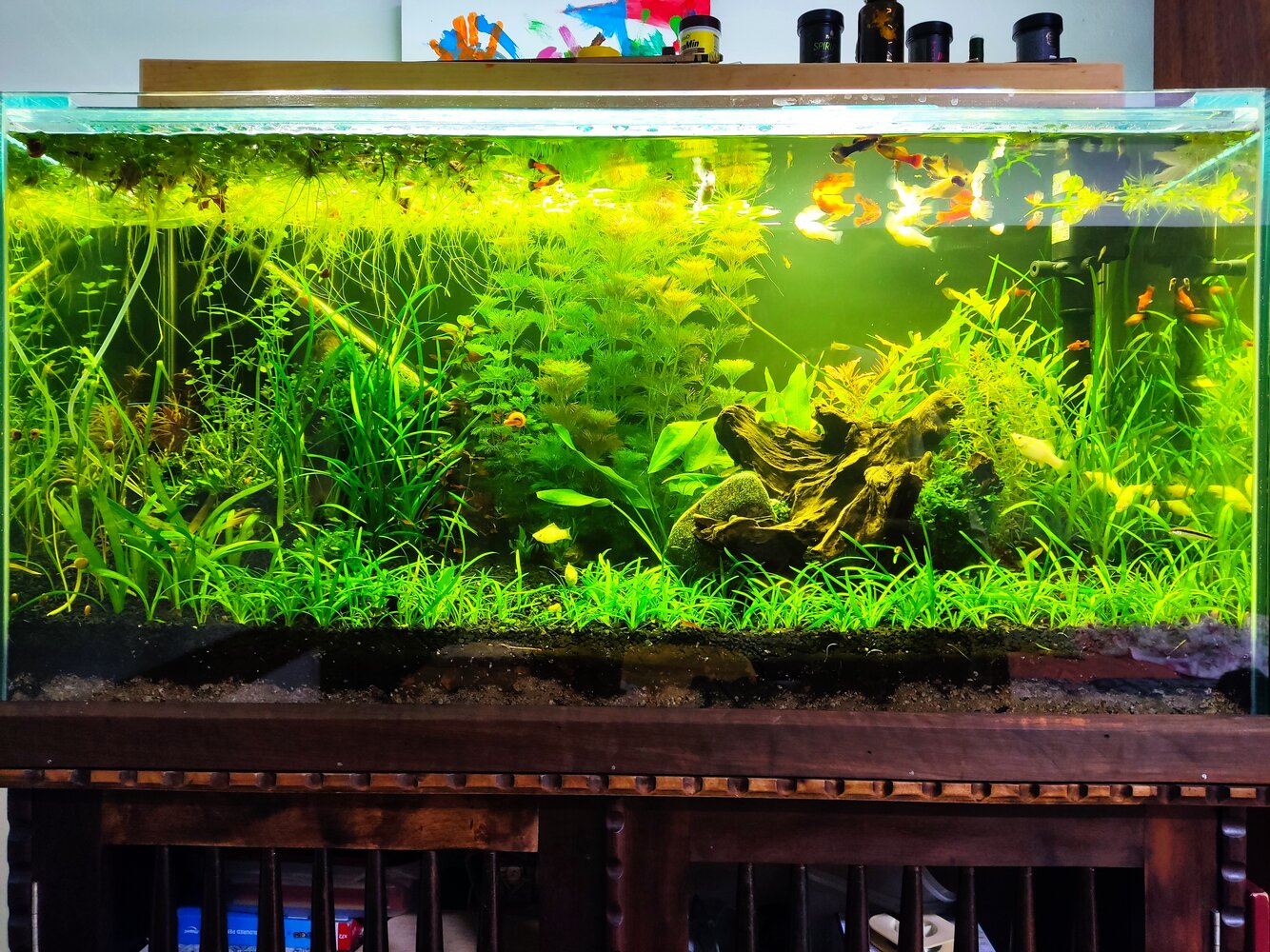
The L. Sessiflora really liked there, and it is starting to take shape.
But there are something going off in this tank.
Since it was a rushed setup for a emergency, I didn't had the time to wait few weeks to put the fish in.
I never had a problem with ammonia before neither did I have this time, but cycling a tank it's not just about nitrifying bacteria.
There are other things too, which I'm not well informed.
The ammonia reading was 0. I don't have access to nitrates or nitrites test kits, so it could be off.
But I can read my fish
Their gills seem fine, but I think that there is a parasite on the gills of some of my fish, because a group of them is gasping near the surface, and some are scratching themselves against the plants, specially the Echinodorus grisebachii, which has harder and rougher leaves.
I noticed also some bumps and swollen areas underneath the skin of some fish, I have read it may be some sort of virus, Lymphocystis, but I'm not sure. They are eating ok.
But I also noticed small reddish spots, like a irregular cell growth inside their bodies, two of my fish had shown this symptoms.
I didn't manage to take a picture.
One fish died, it got some swollen bits deteriorated quite fast, 4 days from the first symptoms to the death.
I read if it is Lymphocystis there is no much we can do, because the virus is already in the water and other fish may be carriers that show no symptom, so there is no reason to remove the assymptomatic ones.
My guess is that I put some contaminated stuff into my tank, through the plants or a assymptomatic fish. I think the first can be right, because I got some trimmings from a friend of mine few days ago, that I didn't quarantine, nor bathed them with potassium permanganate.
I think I may have learnt a lesson...
Either way I would be better off if I had the time to wait every thing to take it's course and develop less rushy.
But at the end of the day it is all about learning and taking notes to not rush things up, taking the time and being a little bit more careful...
Cheers
Jonni
So its been 20 days since the setup.
The aquarium plants are thriving, fish are delivering their fry.
The pH from day one to now went from 7,2 to 7,6. But it stopped there more than week ago.
So I'm quite sure it was the boulder that I place on top of my driftwood that was slowly raising the pH.
After I removed it the pH stayed at the same reading.
I did several small water changes, up to 10% a day, skipping a day here and there. Usually it was about 7-8%
The GH from day one to 10th day raised 5 or 6dGH, then I started performing those small water changes to keep it down, further I removed the stone, this is another reason to think that it was also responsible for raising my pH and my KH, more on that later.
I removed the stone o May 27th, but I was doing some water changes since May 23rd, but the GH kept raising by the next day. With the stone in I managed to reduce it to 13dGH, but it raised shortly after.
After I removed the stone the readings were more consistent
The KH raised from 3dKH to a weak 5dKH after I put the stone into the aquarium on May 16th, so it stayed there for eleven days.
Why I say a weak 5dKH? Because the test didn't become a strong yellow after the fifth drop, but it was yellow nonetheless.
Recently I ask for help identifying a crypto of mine, and it was said it could be a C. Balansae
AndI've grown it a few times, I don't remember the leaf edges being so crenate, or the leaves being that long. But then I grew it low-energy without CO2, and like @ElleDee mentions above, crypts have a great deal of phenotypic plasticity when it comes to leaf morphology, responding to different environmental conditions. So I could be wrong. It does look more like C. balansae though.
My guess would be for 99% Balansae
So I went to my lfs and bought a tissue grow of a Cryptocoryne Crispatula var. balansae. To check if my previous crypto was the same. So I planted it in my tank to see what it turns out.
Ado. (Yet I'm a beginner on identifying aquarium plants.
One part of me thinks "Cryptocoryne Balansae and Cryptocoryne Crispatula var. balansae are the same plant"
But other part of me thinks they could be different species therefore I would have two types balansae? Is that so? Or I'm just tripping?
They are different, the leaves in the newer one was way more crenate than my previous one when I first bought it. So that could be a Cryptocoryne Spiralis, as I found it on sale on the same fish store that I bought it back then.
But, when I bought my first crypto, I didn't buy I tissue growth, I bought it already in the the submerged form.
But the store owner told me that he has the C. Spiralis in vitro and submerged grown. I didn't asked about the C. balansae, shame on me.)
I also added a small portion of C. wendtii "Green Gecko"

and my first buce: Bucephalandra Brownie Ghost:

Yep, they are really small.
I payed R$38,00 for each Cryptocoryne (tissue growth) and R$65,00 for the buce (it came two small portion, but the second I planted behind the driftwood in a shaded area with more water flow.
I don't have any pictures of the C. crispatula var. balansae.
On May 30th, the plants were quite overgrown.

The Limnophila sessiflora, grew quite large very quickly, and send side shoots in many stems (in the previous tank it didn't happen as much as it happened in this one)
The floating plants took over the surface in no time, the new plants had shorter roots, which I think was because they came from an outside bucket with almost no plant food to an aquarium rich in plant food and ferts (DIY KCl and Seashem Flourish)
So I decided to squip the fertilization this week
After the trimmings it got like this:

(First trimmings, May 30th)
But It has already overgrown.
This is the picture of my tank now:

The L. Sessiflora really liked there, and it is starting to take shape.
But there are something going off in this tank.
Since it was a rushed setup for a emergency, I didn't had the time to wait few weeks to put the fish in.
I never had a problem with ammonia before neither did I have this time, but cycling a tank it's not just about nitrifying bacteria.
There are other things too, which I'm not well informed.
The ammonia reading was 0. I don't have access to nitrates or nitrites test kits, so it could be off.
But I can read my fish
Their gills seem fine, but I think that there is a parasite on the gills of some of my fish, because a group of them is gasping near the surface, and some are scratching themselves against the plants, specially the Echinodorus grisebachii, which has harder and rougher leaves.
I noticed also some bumps and swollen areas underneath the skin of some fish, I have read it may be some sort of virus, Lymphocystis, but I'm not sure. They are eating ok.
But I also noticed small reddish spots, like a irregular cell growth inside their bodies, two of my fish had shown this symptoms.
I didn't manage to take a picture.
One fish died, it got some swollen bits deteriorated quite fast, 4 days from the first symptoms to the death.
I read if it is Lymphocystis there is no much we can do, because the virus is already in the water and other fish may be carriers that show no symptom, so there is no reason to remove the assymptomatic ones.
My guess is that I put some contaminated stuff into my tank, through the plants or a assymptomatic fish. I think the first can be right, because I got some trimmings from a friend of mine few days ago, that I didn't quarantine, nor bathed them with potassium permanganate.
I think I may have learnt a lesson...
Either way I would be better off if I had the time to wait every thing to take it's course and develop less rushy.
But at the end of the day it is all about learning and taking notes to not rush things up, taking the time and being a little bit more careful...
Cheers
Jonni
Last edited:























